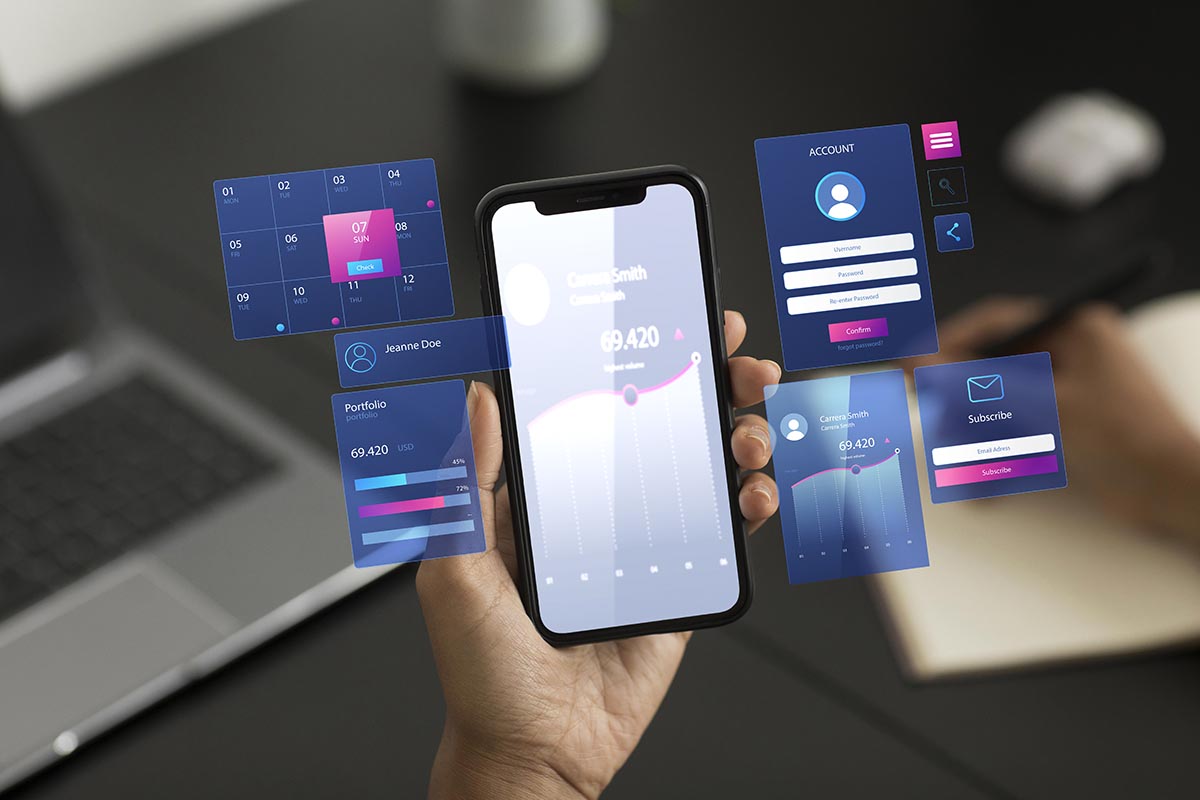Typical Errors in Mobile App Development and How to Prevent Them
KEY POINTS
- Common mobile app development errors include security vulnerabilities, performance issues, and neglecting user experience, leading to potential breaches and user dissatisfaction.
- The importance of regular updates and customer support is often overlooked, risking app obsolescence and user abandonment due to unresolved issues or outdated features.
- Inadequate testing across different devices can result in app failures, crashes, and technical glitches, undermining the app’s reliability and user trust.
The process of developing a mobile app is an exciting one. Still, it’s also full of obstacles and blunders since the industry is dynamic and innovation meets constantly changing consumer expectations. However, only a small percentage of applications will succeed.
Over-encounter the destiny of being used just once before encountering the erase button. This startling statistic highlights the frequent errors developers unintentionally make while creating apps.
Let’s look closely at common errors made while developing mobile apps to learn what goes wrong and how to fix them.
The fragmentation of the mobile ecosystem is one of the major areas where there is room for improvement in the creation of mobile apps. Given the variety of devices, operating systems, and screen sizes, it might be difficult to guarantee a flawless user experience across all platforms.
Developers need to be very mindful of compatibility concerns to avoid turning off a segment of their prospective user base.
A full stack development company combines diverse experience and skill to create complete digital solutions that cut over conventional confines. They do this by skillfully negotiating the complexity of front- and back-end technology.
Worries about security
One of the biggest concerns when developing mobile apps is security. Vulnerabilities that hackers may exploit might result from bad data storage methods, insufficient authentication procedures, and weak encryption. A solitary security breach has the potential to do irreversible harm to a brand’s image and undermine user confidence.
Enhancement of performance
Users tend to rapidly lose interest in mobile applications that utilize excessive resources, deplete batteries, or have poor launch times. A great mobile app must strike a balance between usefulness and resource efficiency.
Why is a mobile app bad?
These are some common errors in mobile app development that, if caught early on, may help make the final product look better and work more smoothly.
- Inadequate user experience (UX)
A great mobile application is often the result of the user experience needing to be prioritized more. Users may get irritated and leave due to confusing navigation, confusing interfaces, and an overwhelming amount of ads. A mobile application’s success is largely dependent on its smooth and user-friendly design.
- Absence of assistance and updates
An app that has the potential to be fantastic might become subpar if it doesn’t provide frequent updates and customer support. Paying attention to these elements might result in desertion, as users anticipate bug patches, feature additions, and compatibility updates to keep their applications functioning properly.
- Insufficient examination
An app that is flawed may be the consequence of rushing the testing process or skipping thorough testing on a variety of devices. An otherwise promising mobile application might have its reputation damaged by glitches, crashes, and other technical problems.
- Inadequate security protocols
There’s a big obligation to protect user data for mobile applications that handle sensitive information. Strong security procedures are necessary to stop vulnerabilities such as data breaches and illegal access.
This entails putting strong encryption techniques into place, storing data securely, and conducting frequent security assessments. Ignoring these factors may result in compromised customer privacy, data breaches, legal issues, and a major decline in user confidence.
Furthermore, in the current digital era, rumors about security flaws proliferate swiftly and might permanently harm an app’s user base and reputation.
- Inadequate architectural design
A mobile app’s architecture serves as its framework, dictating how effectively it works and expands over time. Bad architectural decisions may cause issues with the app’s performance, upkeep, and integration of new features and technologies, among other things.
A well-thought-out architecture should be modular, scalable, and maintained to facilitate growth and modifications. It should also use resources effectively so that the application runs smoothly on a variety of hardware and operating systems.
Ignoring the architecture might lead to an app that is difficult to use and expensive to maintain, which will hurt the development process as well as the user experience.
Why do the majority of applications not work?
Though there is a lot of innovation and promise in the mobile app development space, not all applications are successful. App failure rates are high due to a number of variables. Let’s examine some typical blunders made in the creation of mobile applications as well as the reasons why many of them don’t have a lasting effect.
⛔Issue: Insufficient market research might lead to the creation of an app that either doesn’t meet a real demand or is up against fierce competition.
✅Solution: For an app to be effective, it is essential to comprehend the target market, examine industry trends, and pinpoint customer pain points.
Bad user experience (UX) problem: Applications with muddled interfaces, sluggish performance, or poor usability often cause users to give up on them.
✅Solution: To keep people interested and engaged, responsive performance, simplified navigation, and straightforward design must come first.
Ineffective monetization tactics Problem: Users may get disinterested in monetization techniques that interfere with their experience, including invasive advertisements or excessive upfront expenditures.
✅Solution: Selecting the right monetization strategies, including in-app or freemium purchases, and striking a balance between revenue targets and user delight are crucial factors.
Inadequate promotion and awareness
⛔Problem: Apps that are poorly developed may still not succeed if their marketing plans are ineffective. With millions of applications available, getting noticed is a big problem.
✅Solution: To increase app exposure and draw consumers, use comprehensive marketing strategies that make use of social media, app store optimization (ASO), and strategic partnerships.
⛔Ignoring consumer input: If an app is not updated to reflect user feedback, it may become stagnant and lose its ability to captivate users.
✅Solution: A more responsive and user-centric strategy is fostered by creating avenues for user feedback, aggressively resolving issues, and regularly upgrading the app depending on user input.
Technical problems and bugs
Applications with a lot of crashes, glitches, or poor performance may lose users and damage the app’s reputation.
✅Solution: An application becomes more stable and dependable via thorough testing, ongoing debugging, and quick resolution of technical problems.
Disregarding the platform’s rules
⛔Problem: Failure to follow platform-specific requirements for Android and iOS might lead to an unwelcome app experience that detracts from the user experience.
✅Solution: Complying with platform rules guarantees that the application works flawlessly with the operating system, giving users a comfortable and easy-to-use interface.
Insufficient assistance and updates
⛔Problem: When updates and customer support are neglected, an out-of-date program that falls short of changing user expectations results.
✅Resolution: Sustaining user pleasure and loyalty requires frequent updates, problem-solving, and attentive customer service.
Not adjusting to new trends
⛔Problem: Apps risk becoming antiquated if they don’t adopt new technology or adjust to shifting user habits.
✅Solution: To make sure the app stays relevant in a changing industry, it is important to stay up to date on new trends, integrate pertinent technology, and adapt to user preferences.
What are typical design errors in mobile apps?
- Excessively complex user interfaces
A typical design error is an overly complicated and crowded user interface. Consumers want things to be simple, so giving them too many features or choices might confuse and irritate them. The phrase SaaS application development perfectly captures how software distribution has evolved, transforming conventional approaches into evolving, scalable solutions that provide consumers easy access to and adaptability in the digital sphere.
- Disregarding the platform’s rules
Every mobile platform (Android, iOS) has its own set of design standards. Disregarding these recommendations may cause an app to seem inappropriate for a certain platform, which will lower user happiness.
- Disparities across platforms
Users may get confused if an app acts differently on iOS and Android smartphones. A consistent user experience depends on functionality and design being consistent.
How can errors in mobile apps be avoided?
Developers may lessen difficulties by taking preventative measures and making use of the knowledge gained from successes and failures.
- The agile technique for development
Using an agile development process makes it easier to be flexible and adaptable while working on a project. Developers can react quickly to changing needs because to regular sprints, continuous communication, and incremental updates, which lowers the chance of major setbacks.
- Design thinking that is user-centric
The app will connect with its target market by putting the user experience first and using design thinking techniques. A user-centric attitude is fostered by doing user research and iterating based on input, which increases user engagement and happiness.
- A cooperative culture and communication within the team
Frequent team meetings, open lines of communication, and a common understanding of the objectives of the project facilitate a coordinated and practical development environment.
A communication breakdown is the biggest problem in the creation of mobile apps. Overcoming communication failures requires cultivating a collaborative team culture.
Inadequate communication among developers, designers, and stakeholders may result in miscommunication, missed deadlines, and a product of inferior quality. To overcome this obstacle, a cooperative team atmosphere, transparent documentation, and frequent meetings are essential.
- Ongoing education and skill improvement
Given how quickly technology is developing, developers need to make a commitment to lifelong learning. Keeping up with developing technologies, industry trends, and changing best practices enables developers to make well-informed choices and put creative ideas into effect.
- Adopting DevOps procedures
Collaboration between the development and operations teams is improved via integration within the development lifecycle. Development pipeline efficiency and quicker, more dependable releases are enhanced by automated testing, continuous integration, and simplified deployment procedures.
- Sturdy security procedures
Resolving security issues necessitates taking the initiative. In-depth security assessments, encryption implementation, and constant vigilance against new threats are all recommended for developers. Ensuring the protection of user data and app integrity requires giving priority to security right from the start.
- Beta testing and community involvement
Participating in beta testing with the app’s user base may provide priceless information. Early adopters may point out errors, make suggestions for enhancements, and provide a variety of viewpoints, all of which help to make the final product more polished and refined.
Mobile app development services combine user-centered design and expert coding to create innovative concepts that flow naturally into our everyday digital life. They also handle the complexities of platform compatibility and client satisfaction.
- Planning for scalability
Developers should account for the app’s expansion from the outset in order to guarantee scalability. The application can manage growing user traffic and changing needs by using scalable design, streamlining database performance, and monitoring server loads.
Although there is potential in mobile app development, developers must exercise caution to prevent frequent dangers and errors when getting around the app development process.
A mobile app project’s success may be greatly increased by addressing flaws, setting priorities, minimizing design errors, and encouraging efficient communication. By considering these things, developers may produce applications in this cutthroat and ever-changing market that both meet and surpass user expectations.
With a strong grasp of the industry, dedication to user experience, and a proactive attitude towards adaptation and enhancement, developers may enhance the likelihood of developing applications that endure and prosper in the fiercely competitive mobile application marketplace.
Typical Errors in Mobile App Development and How to Prevent Them
The process of developing a mobile app is an exciting one, but it’s also full of obstacles and blunders since the industry is dynamic and innovation meets constantly changing consumer expectations.
However, only a small percentage of applications will succeed.
Over-encounter the destiny of being used just once before encountering the erase button. This startling statistic highlights the frequent errors developers unintentionally make while creating apps.
To learn what goes wrong and how to fix it, let’s take a closer look at common errors made while developing mobile apps.
The fragmentation of the mobile ecosystem is one of the major areas where there is room for improvement in the creation of mobile apps. It might be difficult to guarantee a flawless user experience across all platforms, given the variety of devices, operating systems, and screen sizes.
Developers need to be very mindful of compatibility concerns so as not to turn off a segment of their prospective user base. A full-stack development company combines diverse experience and skill to create complete digital solutions that cut over conventional confines. They do this by skillfully negotiating the complexity of front- and back-end technology.
- Worries about security
One of the biggest concerns when developing mobile apps is security. Vulnerabilities that hackers may exploit might result from bad data storage methods, insufficient authentication procedures, and weak encryption. A solitary security breach has the potential to do irreversible harm to a brand’s image and undermine user confidence.
- Enhancement of performance
Users tend to rapidly lose interest in mobile applications that utilize excessive resources, deplete batteries, or have poor launch times. A great mobile app must strike a balance between usefulness and resource efficiency.
Why is a mobile app bad?
These are some common errors in mobile app development that, if caught early on, may help make the final product look better and work more smoothly.
- Inadequate user experience (UX)
A great mobile application is often the result of the user experience needing to be prioritized more. Users may get irritated and leave due to confusing navigation, confusing interfaces, and an overwhelming amount of ads. A mobile application’s success is largely dependent on its smooth and user-friendly design.
- Absence of assistance and updates
An app that has the potential to be fantastic might become subpar if it doesn’t provide frequent updates and customer support. Paying attention to these elements might result in desertion, as users anticipate bug patches, feature additions, and compatibility updates to keep their applications functioning properly.
- Insufficient examination
An app that is flawed may be the consequence of rushing the testing process or skipping thorough testing on a variety of devices. An otherwise promising mobile application might have its reputation damaged by glitches, crashes, and other technical problems.
- Inadequate security protocols
There’s a big obligation to protect user data for mobile applications that handle sensitive information. Strong security procedures are necessary to stop vulnerabilities such as data breaches and illegal access.
This entails putting strong encryption techniques into place, storing data securely, and conducting frequent security assessments. Ignoring these factors may result in compromised customer privacy, data breaches, legal issues, and a major decline in user confidence.
Furthermore, in the current digital era, rumors about security flaws proliferate swiftly and might permanently harm an app’s user base and reputation.
- Inadequate architectural design
A mobile app’s architecture serves as its framework, dictating how effectively it works and expands over time. Bad architectural decisions may cause issues with the app’s performance, upkeep, and integration of new features and technologies, among other things.
A well-thought-out architecture should be modular, scalable, and maintained to facilitate growth and modifications. It should also use resources effectively so that the application runs smoothly on a variety of hardware and operating systems.
Ignoring the architecture might lead to an app that is difficult to use and expensive to maintain, which will hurt the development process as well as the user experience.
Why do the majority of applications not work?
Though there is a lot of innovation and promise in the mobile app development space, not all applications are successful. App failure rates are high due to a number of variables. Let’s examine some typical blunders made in the creation of mobile applications as well as the reasons why many of them don’t have a lasting effect.
⛔Issue: Insufficient market research might lead to the creation of an app that either doesn’t meet a real demand or is up against fierce competition.
✅Solution: For an app to be effective, it is essential to comprehend the target market, examine industry trends, and pinpoint customer pain points.
⛔Bad user experience (UX) problem: Applications with muddled interfaces, sluggish performance, or poor usability often cause users to give up on them.
✅Solution: To keep people interested and engaged, responsive performance, simplified navigation, and straightforward design must come first.
⛔Ineffective monetization tactics Problem: Users may get disinterested in monetization techniques that interfere with their experience, including invasive advertisements or excessive upfront expenditures.
✅Solution: Selecting the right monetization strategies, including in-app or freemium purchases, and striking a balance between revenue targets and user delight are crucial factors.
Inadequate promotion and awareness
⛔Problem: Apps that are poorly developed may still not succeed if their marketing plans are ineffective. With millions of applications available, getting noticed is a big problem.
✅Solution: To increase app exposure and draw consumers, use comprehensive marketing strategies that make use of social media, app store optimization (ASO), and strategic partnerships.
⛔Ignoring consumer input: If an app is not updated to reflect user feedback, it may become stagnant and lose its ability to captivate users.
✅Solution: A more responsive and user-centric strategy is fostered by creating avenues for user feedback, aggressively resolving issues, and regularly upgrading the app depending on user input.
⛔Technical problems and bugs: Applications with a lot of crashes, glitches, or poor performance may lose users and damage the app’s reputation.
✅Solution: An application becomes more stable and dependable via thorough testing, ongoing debugging, and quick resolution of technical problems.
Disregarding the platform’s rules
⛔Problem: Failure to follow platform-specific requirements for Android and iOS might lead to an unwelcome app experience that detracts from the user experience.
✅Solution: Complying with platform rules guarantees that the application works flawlessly with the operating system, giving users a comfortable and easy-to-use interface.
Insufficient assistance and updates
⛔Problem: When updates and customer support are neglected, an out-of-date program that falls short of changing user expectations results.
✅Resolution: Sustaining user pleasure and loyalty requires frequent updates, problem-solving, and attentive customer service.
Not adjusting to new trends
⛔Problem: Apps risk becoming antiquated if they don’t adopt new technology or adjust to shifting user habits.
✅Solution: To make sure the app stays relevant in a changing industry, it is important to stay up to date on new trends, integrate pertinent technology, and adapt to user preferences.
What are typical design errors in mobile apps?
- Excessively complex user interfaces
A typical design error is an overly complicated and crowded user interface. Consumers want things to be simple, so giving them too many features or choices might confuse and irritate them. The phrase SaaS application development perfectly captures how software distribution has evolved, transforming conventional approaches into evolving, scalable solutions that provide consumers easy access to and adaptability in the digital sphere.
- Disregarding the platform’s rules
Every mobile platform (Android, iOS) has its own design standards. Disregarding these recommendations may cause an app to seem inappropriate for a certain platform, which will lower user happiness.
- Disparities across platforms
Users may get confused if an app acts differently on iOS and Android smartphones. A consistent user experience depends on functionality and design being consistent.
How can errors in mobile apps be avoided?
Developers may lessen difficulties by taking preventative measures and making use of the knowledge gained from successes and failures.
- The agile technique for development
Using an agile development process makes it easier to be flexible and adaptable while working on a project. Developers can react quickly to changing needs because to regular sprints, continuous communication, and incremental updates, which lowers the chance of major setbacks.
- User-centric design thinking
The app will connect with its target market by putting the user experience first and using design thinking techniques. A user-centric attitude is fostered by doing user research and iterating based on input, which increases user engagement and happiness.
A cooperative culture and communication within the team
Frequent team meetings, open lines of communication, and a common understanding of the project’s objectives facilitate a coordinated and practical development environment.
A communication breakdown is the biggest problem in the creation of mobile apps. Overcoming communication failures requires cultivating a collaborative team culture.
Inadequate communication among developers, designers, and stakeholders may result in miscommunication, missed deadlines, and a product of inferior quality. A cooperative team atmosphere, transparent documentation, and frequent meetings are essential to overcome this obstacle.
Ongoing education and skill improvement
Given how quickly technology is developing, developers need to make a commitment to lifelong learning. Keeping up with developing technologies, industry trends, and changing best practices enables developers to make well-informed choices and implement creative ideas.
Adopting DevOps procedures
Collaboration between the development and operations teams is improved via integration within the development lifecycle. Automated testing, continuous integration, and simplified deployment procedures enhance pipeline efficiency and quicker, more dependable releases.
Sturdy security procedures
Resolving security issues necessitates taking the initiative. In-depth security assessments, encryption implementation, and constant vigilance against new threats are all recommended for developers. Ensuring the protection of user data and app integrity requires prioritizing security right from the start.
Beta testing and community involvement
Participating in beta testing with the app’s user base may provide priceless information. Early adopters may point out errors, make suggestions for enhancements, and provide a variety of viewpoints, all of which help to make the final product more polished and refined.
Mobile app development services combine user-centered design and expert coding to create innovative concepts that flow naturally into our digital lives. They also handle the complexities of platform compatibility and client satisfaction.
Planning for scalability
Developers should account for the app’s expansion from the outset to guarantee scalability. The application can manage growing user traffic and changing needs by using scalable design, streamlining database performance, and monitoring server loads.
Although there is potential in mobile app development, developers must exercise caution to prevent frequent dangers and errors when getting around the app development process.
A mobile app project’s success may be significantly increased by addressing flaws, setting priorities, minimizing design errors, and encouraging efficient communication. By considering these things, developers may produce applications in this cutthroat and ever-changing market that meet and surpass user expectations.
With a strong grasp of the industry, dedication to user experience, and a proactive attitude towards adaptation and enhancement, developers may enhance the likelihood of developing applications that endure and prosper in the fiercely competitive mobile application marketplace.
























